.
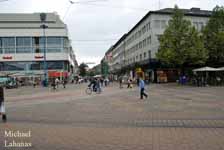
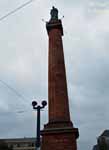

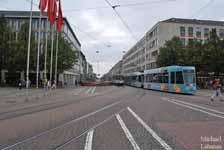
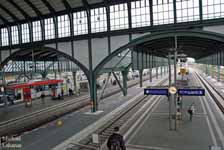

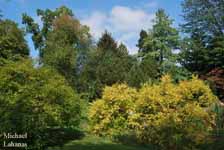
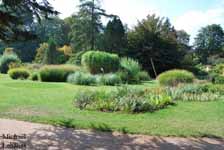
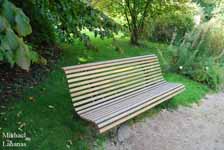

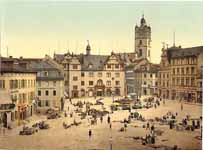
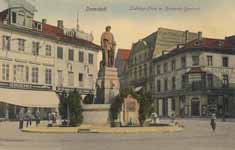
Darmstadt
Darmstadt is a city in the Bundesland (federal state) of Hesse in Germany, located in the southern part of the Rhine Main Area.
The sandy soils in the Darmstadt area, ill-suited for agriculture in times before industrial fertilisation,[2] prevented any larger settlement from developing, until the city became the seat of the Landgraves of Hessen-Darmstadt in the 16th century.
As the administrative centre of an increasingly prosperous duchy, the city gained in prominence during the following centuries. In the 20th century, industry (especially chemicals) as well as large science and electronics (later information technology) sectors became increasingly important, and are still a major part of the city's economy. Darmstadt also has a large tertiary education sector, with three major universities and numerous associated institutions.[3]
Darmstadt is one of few cities (as opposed to smaller towns) in Germany which does not lie close to a river, lake or coast. It can also boast being the sunniest city in the state of Hesse.[4] The chemical element Darmstadtium (atomic number 110) is named after it, having been synthetisized in the GSI Centre for Heavy Ion Research in Darmstadt-Wixhausen.
History
Origins
The name Darmstadt first appears towards the end of the 11th century, then Darmundestat. Literally translated, the current German name Darmstadt means "Intestine City." This is just a coincidence however, and the origins of the name are unknown.[5] 'Dar-mund' in Middle Low German is translated as "Boggy Headlands", but it could be a misspelling in local dialect of another name. Even locals often believe, incorrectly, that the name derives from the 'Darmbach' (a small stream formerly running through the city). In fact the stream received its current name much later, after the city, not vice versa.[5]
Darmstadt was chartered as a city by the Holy Roman Emperor Ludwig the Bavarian in 1330, at which time it belonged to the counts of Katzenelnbogen.[6] The city, then called Darmstait, became a secondary residence for the counts, with a small castle being established at the site of the current, much larger edifice. [7]
When the house of Katzenelnbogen became extinct in 1479, the city was passed to the Landgraviate of Hesse, and was seat of the ruling landgraves (1567–1806) and thereafter (to 1918) of the Grand Dukes of Hesse.[8]
Industrial age
The city grew in population during the 19th century from little over 10,000 to 72,000 inhabitants.[9] A polytechnical school, which later became a Technical University now known as TU Darmstadt, was established in 1877.[10]
In the beginning of the 20th century Darmstadt was an important centre for the art movement of Jugendstil, the German variant of Art Nouveau. Annual architectural competitions led to the building of many architectural treasures of this period. Also during this period, in 1912 the chemist Anton Kollisch, working for the pharmaceutical company Merck, first synthesised the chemical MDMA (ecstasy) in Darmstadt. Darmstadt's municipal area was extended in 1937 to include the neighbouring localities of Arheilgen and Eberstadt, and in 1938 the city was separated administratively from the surrounding district (Kreis).
Nazi Germany
Darmstadt was the first city in Germany to force Jewish shops to close in early 1933, shortly after the Nazis took power in Germany (during this first incident, shops were only closed for a day, for "endanger[ing] communal order and tranquility")[11] In 1942, over 3,000 Jews from Darmstadt were first forced into a collection camp located in the Liebigschule, and then later deported to concentration camps[12] where most eventually died.
Some prominent members of the German resistance against the Nazis were citizens of Darmstadt (e.g. Wilhelm Leuschner and Theodor Haubach, both executed for their opposition to the regime).[citation needed]
Darmstadt's old city centre was largely destroyed in a British bombing raid on Darmstadt on 11 September 1944 (Darmstadt had first been raided on 30 July 1940, one of 35 attacks to come). This attack on Darmstadt was an early use of the firestorm technique – subsequently used on the city of Dresden in February 1945 – where a number of incendiary bombs are dropped around the city before explosive blast bombs are dropped to begin a self-sustaining combustion process where the winds generated by the fire are sufficient to ensure it continues to burn. Darmstadt was selected as the secondary target for the raid, but promoted to primary target after cloud over the primary would have obscured reconnaissance view of the after-effects. During this worst attack an estimated 11,000–12,500 inhabitants died, and 66,000–70,000 were rendered homeless.[12] Over three quarters of Darmstadt's inner city area was destroyed in the raid,[13] leading to a relatively architecturally plain style of post-war rebuilding, although a number of older buildings were rebuilt in their original styles.
Post-World War II
Throughout the 19th and 20th centuries, Darmstadt became home to many technology companies and research institutes, and has been promoting itself as a "city of science" since 1997. It is well known as a high-tech centre in the vicinity of Frankfurt Airport, with important activities in spacecraft operations (the European Space Operations Centre, European Organisation for the Exploitation of Meteorological Satellites), chemistry, pharmacy, information technology, biotechnology, telecommunications (substantial Deutsche Telekom presence) and mechatronics. In 2000, its region also scored Rank 3 amongst 97 German regions in the WirtschaftsWoche test ranking Germany's high-tech regions.[6]
The TU Darmstadt is one of the important technical institutes in Germany and is well known for its research and teaching in the Electrical, Mechanical and Civil Engineering disciplines. Together with other tertiary institutions, the TU is responsible for the large student population of the city, which stood at 33,547 in 2004.[6]
Geography
Climate
| Climate data for Darmstadt | |||||||||||||
|---|---|---|---|---|---|---|---|---|---|---|---|---|---|
| Month | Jan | Feb | Mar | Apr | May | Jun | Jul | Aug | Sep | Oct | Nov | Dec | Year |
| Record high °C (°F) | 15 (59) |
17 (63) |
24 (75) |
29 (84) |
31 (88) |
35 (95) |
35 (95) |
38 (100) |
30 (86) |
26 (79) |
18 (64) |
15 (59) |
38 (100) |
| Average high °C (°F) | 5 (41) |
7 (45) |
11 (52) |
15 (59) |
20 (68) |
23 (73) |
25 (77) |
25 (77) |
20 (68) |
14 (57) |
8 (46) |
5 (41) |
15 (59) |
| Average low °C (°F) | 0 (32) |
1 (34) |
3 (37) |
6 (43) |
11 (52) |
13 (55) |
15 (59) |
15 (59) |
11 (52) |
7 (45) |
4 (39) |
1 (34) |
7 (45) |
| Record low °C (°F) | −14 (7) |
−12 (10) |
−10 (14) |
−4 (25) |
1 (34) |
3 (37) |
6 (43) |
7 (45) |
2 (36) |
−4 (25) |
−8 (18) |
−11 (12) |
−14 (7) |
| Precipitation mm (inches) | 28 (1.1) |
27 (1.06) |
27 (1.06) |
29 (1.14) |
29 (1.14) |
44 (1.73) |
43 (1.69) |
41 (1.61) |
27 (1.06) |
41 (1.61) |
25 (0.98) |
36 (1.42) |
33 (1.3) |
| Source: Weather2[14] | |||||||||||||
Transport
Darmstadt is relatively typical for German cities in terms of its transport system, with the car being the main, but not overwhelmingly dominant mode of transport.
Roads
Darmstadt is connected to the surrounding areas by a number of major roads, primarily accessing the areas to the north, west and south, including two Autobahn links crossing just west of the city as well as a Bundesstraße also running north-south. The less settled areas east of the city in the Odenwald are accessed by several secondary roads.
Trains
Darmstadt Hauptbahnhof is its main train station, located at the western end of the central city and connects to the rest of Germany and Europe with the Intercity-Express network. There is also a much-utilised S-Bahn link north to Frankfurt am Main and a number of suburban train stations along the high-speed connections and lesser local rail links (two towards the east and into the Odenwald, for example) that still provide passenger services.
Airports
Darmstadt has no airport with scheduled passenger services, with the historic role of such an airport having long been taken over by the Frankfurt Airport nearby.
A modern tram near the Schloss.
Trams and buses
Main article: Trams in Darmstadt
Darmstadt started in 1886 with a steam tram system, that later evolved (with a short period of also including trolleybuses from 1944 to 1963) into a 36.2 km network by 2001.[15] Darmstadt had not scrapped this comparatively extensive network after World War II as many other cities did, though some links were decommissioned in the 1960s and 1970s and replaced by bus lines[15] of which the city also has an extensive network.
However, the 2000s brought a major tram renaissance in Darmstadt (where further reduction of the system had by now long since been stopped), partly thought to have been due to new low-floor trams strongly increasing patronage.[15] A major new line was built to the Darmstadt-Kranichstein suburb, and track duplication and extension in Darmstadt-Arheilgen is ongoing as of 2010. A line to Weiterstadt, a northwestern suburb, is also in advanced planning stages.[15] Substantial parts of the track system were also upgraded and in some cases incorporated in major new beautification works, such as in front of the Hauptbahnhof or the Schloss.
Buildings and attractions
The 'Luisenplatz', main square of Darmstadt. Part of the Ducal Palace is visible in the rear right.
The 'Wasserturm' (a former railway water tower), contains an art gallery and restaurant.
The 'Marktplatz' and the old town hall.
The ducal palace of Darmstadt is located in the city centre. It was the residence of the counts of Hesse-Darmstadt, later as Grand Dukes of Hesse by the grace of Napoleon. Its current look was established in the 18th century. The counts also owned a castle on the Langenberg above the city that was named Castle Frankenstein. This castle dates back to the 13th century, but it was acquired by the counts of Hesse-Darmstadt in 1662.
The Luisenplatz, the largest square of the city, forms the centre of the city and is the main public transport hub. In 1844 the Ludwigsäule (called Langer Lui, meaning Long Ludwig), a 33-meter column commemorating Ludwig I, first Grand Duke of Hesse, was placed in the middle of the square. While the column still stands, the square is today surrounded by mostly modern buildings. The other large city square is the Marktplatz (see image) near the old city hall, only several hundred meters away.
Surviving examples of the Jugendstil period include the Rosenhöhe, a landscaped English-style rose garden from the 19th century, recently renovated and replanted,[16] the Mathildenhöhe,[17] with the Hochzeitsturm ('Wedding tower', also commonly known as the 'Five-Finger-Tower') by Joseph Maria Olbrich and the Russian Chapel and large exhibition halls as well as many private villas built by Jugendstil architects who had settled in Darmstadt. The Russian Chapel was built as a private chapel by the last Tsar of Russia, Nicholas II, whose wife Alexandra was born in Darmstadt.
The Waldspirale ('Forest Spiral'), a residential complex by Austrian Friedensreich Hundertwasser, was built 1998–2000. An almost surreal building, it is internationally famous for its almost absolute rejection of rectangular forms, down to every window having a different shape, the style being a trademark of Hundertwasser's work.
The Botanischer Garten der TU Darmstadt is a botanical garden and arboretum containing a fine collection of rare trees.
Darmstadt's central train station, Darmstadt Hauptbahnhof, built in 1912 is at the west end of the city. Both local and inter-city trains stop at the station. The station also serves as a stop for buses and streetcars.[18]
Every year around early July the Heinerfest festival is held in the streets surrounding the old ducal palace. It is a traditional German festival with music acts, beer halls, amusement rides and booths selling trinkets and food. The similar 'Schloßgrabenfest', which is more live music-oriented, is held in the same location every year in May. These two festivals attract 700,000[19] and 400,000[20] visitors respectively.
Institutions
Schools
Darmstadt has many good elementary and high schools. One is the katholic secondary school Edith-Stein-Schule.
Technology
The ESOC building.
Darmstadt is the site of the Technische Universität Darmstadt, renowned for its engineering departments, and of the Darmstadt University of Applied Sciences. Related institutes are four Institutes of the Fraunhofer Society, and the Gesellschaft für Schwerionenforschung (GSI, "Society for Heavy Ion Research"), which operates a particle accelerator at its Wixhausen site.
The GSI, amongst other elements, discovered the chemical element Darmstadtium (atomic number: 110), named after the city in 2003. This makes Darmstadt one of only eight cities with an element named after it (the other cities being Ytterby in Sweden (four elements); Stockholm in Sweden (Holmium); Strontian in Scotland; Copenhagen in Denmark (whose Latin name gives Hafnium); Paris (whose Latin name gives Lutetium); Berkeley, California; and Dubna in Russia). Various other elements, including Meitnerium (atomic number: 109) (1982), Hassium (atomic number: 108) (1984), Roentgenium (atomic number: 111) (1994) and Copernicium (atomic number: 112) (1996) were also synthesized in the Darmstadt facility.
The European Space Operations Centre (ESOC) of the European Space Agency is located in Darmstadt. From here, various deep-space exploration spacecraft and Earth-orbiting satellites are operated for the purposes of scientific research, and tecnnology development and demonstration.
EUMETSAT, the European Organisation for the Exploitation of Meteorological Satellites, operates the principal European meteorological satellites from its headquarters, including the first and second generations of Meteosat geostationary satellites, and the polar-orbiting Metop series.
Darmstadt is a centre for the pharmaceutical and chemical industry, with Merck, Röhm and Schenck RoTec (part of The Dürr Group) having their main plants and centres here.
Culture
The 'Jazz-Institut Darmstadt' is Germany's largest publicly accessible Jazz archive.[21]
The 'Internationales Musikinstitut Darmstadt', harboring one of the world's largest collections of post-war sheet music,[22] also hosts the biennial Internationale Ferienkurse für Neue Musik, a summer school in contemporary classical music founded by Wolfgang Steinecke. A large number of avant-garde composers have attended and given lectures there, including Olivier Messiaen, Luciano Berio, Milton Babbitt, Pierre Boulez, Luigi Nono, John Cage, György Ligeti, Iannis Xenakis, Boris Porena, Karlheinz Stockhausen and Mauricio Kagel.
The 'Deutsche Akademie für Sprache und Dichtung' (German Academy for Language and Poetry) provides writers and scholars with a place to research the German language.[23] The Academy's annual Georg Büchner Prize, named in memory of Georg Büchner, is considered the most prestigious literary award for writers of German language.
United States Military presence
U.S. forces entered the city of Darmstadt on 25 March 1945. At the end of World War II, Darmstadt was among the 112 communities where U.S. Forces were stationed. Early units stationed here included elements of the U.S. Constabulary, Air Force units and a Quartermaster School.
Over the years, the U.S. military community Darmstadt — under a variety of designations — served as home for thousands of American soldiers and their families. It included six principal installations in Darmstadt and nearby Babenhausen, Griesheim and Münster, plus several housing areas, an airfield and a large number of smaller facilities as far away as Bensheim and Aschaffenburg. The military newspaper European Stars and Stripes also had its headquarters there. As of 1993, the Darmstadt military community also assumed responsibility for the remaining U.S. Army facilities in the Frankfurt area.
As part of the U.S. Army's ongoing transformation in Germany, the Darmstadt military community, by then designated U.S. Army Garrison Darmstadt, inactivated on 30 September 2008. Even after the garrison inactivation, however, there are two units still in Darmstadt until new facilities are constructed for them elsewhere: The 66th Military Intelligence Group at the Dagger Complex on Eberstädter Weg, and the Defense Threat Reduction Agency on Nathan Hale Depot. They draw their support from the nearby U.S. Army Garrison Wiesbaden.
Notable persons
Karl-Otto Koch, commandant of the Nazi concentration camps at Buchenwald and Sachsenhausen
Boroughs
Darmstadt has 9 official 'Stadtteile' (boroughs). These are, alphabetically:[24]
Darmstadt-Arheilgen
Darmstadt-Bessungen
Darmstadt-Eberstadt
Darmstadt-Kranichstein
Darmstadt-Mitte ('Central')
Darmstadt-Nord ('North')
Darmstadt-Ost ('East')
Darmstadt-West ('West')
Darmstadt-Wixhausen
International relations
See also: List of twin towns and sister cities in Germany
Twin towns / Sister cities
Darmstadt is twinned with:[25]
Netherlands Alkmaar, Netherlands
Italy Brescia, Italy
Turkey Bursa, Turkey[26]
England Chesterfield, England
Austria Graz, Austria[27]
Hungary Gyönk (Tolna County), Hungary
Latvia Liepāja, Latvia
Spain Logroño, Spain
Poland Płock, Poland
Hungary Szeged, Hungary (since 1990)
Norway Trondheim, Norway (since 1968)[28]
France Troyes, France
Ukraine Uzhhorod, Ukraine
Switzerland Saanen, Switzerland
Germany Freiberg, Germany
References
^ "Die Bevölkerung der hessischen Gemeinden" (in German). Hessisches Statistisches Landesamt. June 2011.
^ Micronutrient Status in Two Long-Term Trials with Fertilisation Treatments and Different Cropping Systems – Fischer, Meike et al., Institute for Biodynamic Research, Darmstadt
^ History (from the official city website. Accessed 10 August 2008.)
^ Darmstadt – Hessens sonnigste Stadt (in German) – Frankfurter Rundschau, 16 August 2006
^ a b "Wo kommt er her, wo will er hin?" – Darmstaedter Echo, 2007-12-03, in German. Retrieved 5 January 2008.
^ a b c Essential Facts (brochure) (from the official city website)
^ Nebenresidenz Darmstadt (darmstait) (from the 'Graf v. Katzenelnbogen' website, in German. Retrieved 5 January 2008.)
^ Die Geschichte des Grafenhauses (from the 'Graf v. Katzenelnbogen' website, in German. Retrieved 5 January 2008.)
^ "Population growth in Darmstadt". (from the official city website).
^ "Establishment of TU Darmstadt (in German)". TU Damrstadt.
^ Beginning of the End – Musman, Moshe; from Borne Aloft On The Wings Of A Dove (in-depth feature on Dei'ah veDibur website)
^ a b Darmstädter Stadtgeschichte 20. Jahrhundert (from the official city website, in German, less detailed also in English)
^ Darmstadt history (from the website of the Technical University of Darmstadt)
^ "Climate profile for Darmstadt". Weather2. Retrieved 30 January 2011.
^ a b c d Darmstadt: A mature tramway grows again – Tramways & Urban Transit, September 2001 issue, pp. 334–336. Accessed 7 December 2010.
^ Rosenhöhe – planted with roses (from the official city website)
^ Mathildenhöhe (Artists' Colony) (from the official city website)
^ Darmstadt Hauptbahnhof (private photo gallery)
^ Information about the Heinerfest (in German)
^ Schloßgrabenfest 2006 (in German)
^ Jazz-Institut Darmstadt (official institute website)
^ Internationales Musikinstitut Darmstadt (official institute website, in German)
^ Deutsche Akademie für Sprache und Dichtung (official academy website, in German)
^ Statistischer Ueberblick ('Statistical overview', from the official city website, in German)
^ Town Twinnings and international relations (from the official city website. Accessed 11 August 2008.)
^ Bursa Metropolitan Municipality Web Site; Sister Cities.
^ "Twin Towns – Graz Online – English Version". www.graz.at. Retrieved 5 January 2010.
^ Trondheims offisielle nettsted – Vennskapsbyer
From Wikipedia, All text is available under the terms of the GNU Free Documentation License
